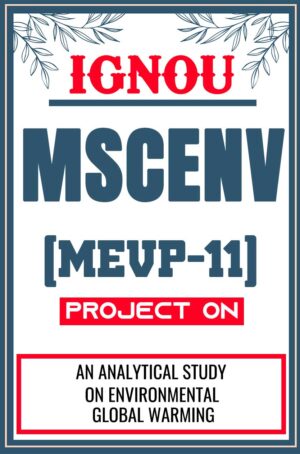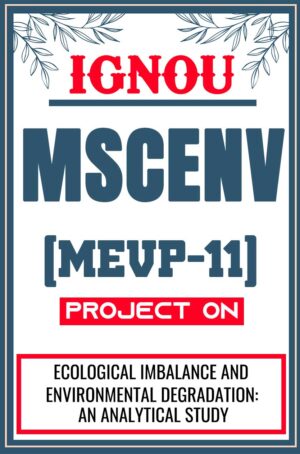Buy IGNOU MSCENV Project for MEVP 11
Master of Science (Environmental Science) Programme aims at generating skilled man power to tackle the growing environmental and developmental problems and changes arising from the transition to a sustainable society. This IGNOU MSCENV Project will give an insight into the socio-economic causes and the characteristics of pollution and degradation of the natural environment, including the effects on human beings, the atmosphere, ecosystem and the other organisms. The IGNOU MSCENV Project will provide learners with the necessary means to develop the capacity to carry out independent assessments on environmental issues.
Whatsapp us to get the Personalized (Customized) IGNOU MSCENV Project Report and Synopsis
Download Link for IGNOU MSCENV Project (MEVP 11 PDF)
What should be included in the introduction of the IGNOU MSCENV Project?
The introduction of an IGNOU MSCENV (Master of Science in Environmental Science) Project for MEVP 11 should set the stage for your research and provide a clear understanding of the project’s context and objectives. Here’s what you should include in the introduction:
1. Background of the Study
- Context: Explain the broader environmental context or issue that your project addresses. Provide background information that helps readers understand why the topic is important.
- Relevance: Discuss the significance of the environmental issue or topic in current scientific, social, or policy contexts. Highlight any trends, challenges, or gaps in knowledge that your project aims to address.
2. Problem Statement
- Specific Issue: Clearly define the specific problem or issue that your research will address. This should be a concise statement that outlines the core challenge or question your project seeks to answer.
3. Research Objectives
- Goals: List the main objectives of your research. These should be specific, measurable, and directly related to addressing the problem statement. For example, objectives might include understanding a particular environmental phenomenon, evaluating the effectiveness of a policy, or assessing the impact of a specific factor on the environment.
4. Research Questions or Hypotheses
- Questions: Formulate the primary research questions that guide your investigation. These questions should align with your objectives and help focus your study.
- Hypotheses: If applicable, state any hypotheses that your research will test. Hypotheses are educated guesses about the relationships or outcomes that your study aims to investigate.
5. Significance of the Study
- Contribution: Explain how your research will contribute to the field of environmental science. Discuss the potential benefits or implications of your findings for environmental management, policy-making, or academic knowledge.
- Stakeholders: Identify who might benefit from your research, such as policymakers, environmental organizations, communities, or the scientific community.
6. Scope of the Study
- Delimitations: Define the scope of your research, including the geographical area, time frame, and specific aspects of the environmental issue you will focus on. Mention any limitations or boundaries that will constrain your study.
7. Structure of the Report
- Outline: Provide a brief overview of how your report is organized. Mention the main sections that will follow in the report, such as the literature review, methodology, findings, and conclusion.
What is the primary goal of the MSCENV project MEVP 11?
The primary goal is to conduct an in-depth study on an environmental issue or topic, demonstrating your understanding and application of environmental science principles. This project aims to contribute to the field with new insights or practical solutions.
What is the word limit for the MSCENV project report?
The word limit typically varies, but a general guideline is to keep the report within 50-100 pages, excluding appendices.
Sample Topics for IGNOU MSCENV Project
- A Study On Attitude, Awareness And Practice Of Women Towards Environmental Protection
- An Observational Study On Women’s Role Towards Environment In Xyz Area
- A Study On Environmental Deterioration Crisis In Srinagar, Jammu & Kashmir
- A Study On Environmental Awareness Among College Students Of Xyz City And Their Concern About Environmental Issues
- Aspects Of Climate Change Contributing To The Vulnerability Of Pastoralist Communities In Jammu & Kashmir
What are the recommended research methods for the IGNOU MSCENV Project?
Here are some commonly recommended research methods for environmental science projects:
Literature Review
- Purpose: To gather and analyze existing research, theories, and data related to your topic.
- Method: Systematic review of scientific papers, books, reports, and other scholarly sources to identify trends, gaps, and context for your research.
Field Surveys
- Purpose: To collect primary data directly from the environment or target population.
- Method: Design and administer surveys or questionnaires to gather information from participants. This can include structured interviews or online surveys.
Experimental Research
- Purpose: To investigate cause-and-effect relationships by manipulating variables.
- Method: Conduct experiments in a controlled setting or field. This could involve lab experiments, controlled field trials, or simulations.
Case Studies
- Purpose: To provide an in-depth analysis of a specific instance or example related to your research topic.
- Method: Detailed examination of individual cases or examples, including interviews, observations, and document analysis.
Data Analysis
- Purpose: To interpret and make sense of quantitative or qualitative data.
- Method: Use statistical tools and software (e.g., SPSS, R, Excel) for quantitative data analysis, or thematic analysis for qualitative data. This could involve statistical testing, trend analysis, and modeling.
Geospatial Analysis
- Purpose: To analyze spatial data and geographic information related to environmental issues.
- Method: Use Geographic Information Systems (GIS) to map and analyze spatial patterns, distributions, and relationships.
Environmental Monitoring
- Purpose: To track and assess environmental variables over time.
- Method: Collect and analyze data on environmental indicators such as air quality, water quality, biodiversity, and pollution levels. This might involve setting up monitoring stations or using remote sensing technologies.
Comparative Studies
- Purpose: To compare different scenarios, locations, or conditions to identify differences or similarities.
- Method: Collect data from multiple sources or sites and compare findings to draw conclusions.
What is the submission process for the IGNOU MSCENV Project?
The submission process for the IGNOU MSCENV (Master of Science in Environmental Science) Project for MSCENV generally involves several key steps. Here’s a detailed guide on the typical submission process:
1. Prepare Your Project Report
- Complete Report: Ensure your project report is complete, including all required sections (e.g., introduction, literature review, methodology, findings, discussion, conclusion, references).
- Format: Follow the specific formatting guidelines provided by IGNOU, including font size, margins, and referencing style. Ensure that your report adheres to these guidelines to avoid issues during submission.
2. Obtain Supervisor Approval
- Review: Submit your project report to your project supervisor for review. They will provide feedback and suggest revisions.
- Approval: Make necessary revisions and obtain formal approval from your supervisor. This approval may be required in the form of a signed certificate or letter.
3. Prepare Supporting Documents
- Project Submission Form: Fill out any required submission forms provided by IGNOU. These forms may include personal details, project title, and details about your supervisor.
- Declaration of Originality: Prepare a declaration of originality, stating that the work is your own and has not been submitted elsewhere.
- Supervisor’s Certificate: Include a certificate or letter from your supervisor confirming their approval of your project.
4. Submit the Project Report
- Hard Copy Submission: Prepare and submit the required number of hard copies of your project report to the designated IGNOU study center or regional center. The number of copies required will be specified by IGNOU.
- Soft Copy Submission: If required, submit a soft copy of your project report via email or through an online portal, as per IGNOU’s guidelines.
5. Adhere to Deadlines
- Submission Deadline: Ensure that you submit your project report before the specified deadline. Late submissions may result in penalties or delays in evaluation.
6. Confirmation of Submission
- Receipt: Obtain a receipt or confirmation of submission from the study center or regional center. This may be in the form of a stamped acknowledgment slip or a confirmation email.
7. Follow Up
- Track Status: Monitor the status of your project submission and evaluation. You may need to follow up with the study center or regional center if there are any issues or delays.
8. Post-Submission Activities
- Project Viva (if applicable): Prepare for a viva voce or oral examination if required as part of your project evaluation. This is an opportunity to present and discuss your project findings with evaluators.
- Revisions: Be prepared to make additional revisions or address feedback provided by the evaluators if required.
How do you handle large volumes of data in your IGNOU MSCENV Project?
Handling large volumes of data effectively is crucial for ensuring that your project remains organized, accurate, and manageable. Here’s a step-by-step guide on how to handle large volumes of data in your MSCENV (Master of Science in Environmental Science) project for MEVP 11:
Organize Your Data
- Create a Data Management Plan: Outline how you will collect, store, and process your data. Include details about data formats, storage locations, and backup procedures.
- Use Naming Conventions: Develop a consistent naming convention for your files and data sets. This will help in organizing and retrieving data efficiently.
Data Collection and Storage
- Data Collection Tools: Use appropriate tools and technologies for data collection, such as digital sensors, GPS devices, or data loggers, to ensure accuracy and efficiency.
- Database Systems: Store your data in a structured database system (e.g., Microsoft Access, SQL databases) that can handle large volumes of data and allows for easy retrieval and manipulation.
Data Cleaning and Preparation
- Data Cleaning: Identify and correct errors, inconsistencies, or missing values in your data. This process is essential to ensure the accuracy and reliability of your analysis.
- Data Transformation: Convert data into a usable format, such as normalizing values, categorizing data, or aggregating results as needed for analysis.
Data Analysis
- Use Statistical Software: Utilize statistical software (e.g., SPSS, R, Python) for complex analyses. These tools can handle large datasets and provide powerful analytical capabilities.
- Data Visualization: Employ data visualization tools (e.g., Tableau, Excel, GIS software) to create graphs, charts, and maps that make your data easier to interpret and present.
Data Management Tools
- Spreadsheet Software: For smaller datasets, use spreadsheet software (e.g., Microsoft Excel) with features like filtering, sorting, and pivot tables to manage and analyze data.
- Big Data Technologies: For extremely large datasets, consider using big data technologies like Hadoop or Spark, which are designed to handle and process large volumes of data efficiently.
Data Security and Backup
- Data Security: Implement security measures to protect your data from unauthorized access or breaches. This may include encryption, access controls, and secure data storage.
- Backup: Regularly back up your data to prevent loss due to technical issues or accidental deletion. Use both physical (external drives) and cloud-based backup solutions.
Documentation
- Data Documentation: Maintain detailed documentation of your data collection methods, variables, and any transformations or analyses performed. This will help ensure transparency and reproducibility.
- Metadata: Create metadata that describes the data, including its source, format, and any processing steps. Metadata helps in understanding and interpreting the data.
Efficient Data Handling
- Chunking: Break down large datasets into smaller, manageable chunks for analysis. This can improve processing speed and reduce memory usage.
- Data Aggregation: Aggregate data where appropriate to simplify analysis. For example, summarize data by regions, time periods, or categories.
How is the IGNOU MSCENV Project report evaluated by the examiners?
The evaluation of the project report for the IGNOU MSCENV Project by the examiners involves a comprehensive assessment of several key aspects. Here’s a detailed overview of how the project report is typically evaluated:
1. Relevance and Originality
- Relevance: Examiners assess whether the project addresses a significant environmental issue or research question. The relevance of the study to current environmental challenges and its potential impact on the field are considered.
- Originality: The originality of the research is evaluated to determine if the project offers new insights, approaches, or findings that contribute to the field of environmental science.
2. Research Objectives and Problem Statement
- Clarity and Specificity: The clarity of the research objectives and problem statement is assessed. Examiners look for a well-defined problem and specific, measurable objectives.
- Justification: The justification for the research problem and its significance is evaluated. The project should clearly explain why the research is important and how it addresses a gap in existing knowledge.
3. Literature Review
- Comprehensiveness: The literature review is evaluated based on its depth and breadth. Examiners check whether the review covers relevant studies, theories, and findings related to the research topic.
- Integration: Examiners assess how well the literature review is integrated into the research, including how it informs the research questions, methodology, and interpretation of results.
4. Methodology
- Appropriateness: The appropriateness and justification of the research methodology are reviewed. Examiners look for a well-defined and suitable research design, including data collection and analysis methods.
- Detail: The level of detail in describing the methodology is evaluated. The methodology should be described clearly enough to allow for replication and should include all relevant procedural details.
5. Data Collection and Analysis
- Accuracy and Reliability: The accuracy and reliability of the data collected are assessed. Examiners check whether the data collection methods were valid and whether the data is reliable and representative.
- Analysis: The thoroughness and appropriateness of data analysis are evaluated. Examiners look for correct application of analytical techniques and proper interpretation of results.
6. Results and Findings
- Presentation: The clarity and organization of the presentation of results are reviewed. Examiners assess whether the results are presented in a logical and understandable manner, using appropriate tables, graphs, and charts.
- Interpretation: The interpretation of results is evaluated to determine if the findings are accurately and insightfully discussed in relation to the research objectives and literature review.
7. Discussion and Conclusion
- Insightfulness: The discussion section is evaluated for its depth and insightfulness. Examiners assess whether the discussion provides meaningful interpretations, explanations, and implications of the findings.
- Conclusions: The conclusions are reviewed to ensure they are well-supported by the data and address the research questions. Recommendations for future research or practical applications are also considered.
8. Organization and Presentation
- Structure: The overall organization and structure of the report are assessed. Examiners look for a logical flow and coherence throughout the report, including clear headings and subheadings.
- Clarity and Style: The clarity of writing, grammar, and formatting are evaluated. The report should be professionally presented, free of errors, and adhere to the formatting guidelines provided by IGNOU.
9. Referencing and Citations
- Accuracy: The accuracy of citations and references is reviewed. Examiners check whether all sources are correctly cited and referenced in the report.
- Consistency: The consistency of the referencing style is assessed to ensure adherence to the required guidelines.
Ready to get your IGNOU MSCENV Project Report and Synopsis Sample PDF for MEVP 11?
- Call us or WhatsApp us at: 9958947060, 9354637830
- Visit: SHRICHAKRADHAR.COM
-
Sale!

-
Sale!

IGNOU MSCENV Project (MEVP-11) Synopsis/Proposal & Project Report/Dissertation in Hard-Copy (Sample-5)
Original price was: ₹499.00.₹249.00Current price is: ₹249.00. -
Sale!

IGNOU MSCENV Project (MEVP-11) Synopsis/Proposal & Project Report/Dissertation in Hard-Copy (Sample-4)
Original price was: ₹499.00.₹249.00Current price is: ₹249.00. -
Sale!

IGNOU MSCENV Project (MEVP-11) Synopsis/Proposal & Project Report/Dissertation in Hard-Copy (Sample-3)
Original price was: ₹499.00.₹249.00Current price is: ₹249.00. -
Sale!

IGNOU MSCENV Project (MEVP-11) Synopsis/Proposal & Project Report/Dissertation in Hard-Copy (Sample-2)
Original price was: ₹499.00.₹249.00Current price is: ₹249.00. -
Sale!

IGNOU MSCENV Project (MEVP-11) Synopsis/Proposal & Project Report/Dissertation in Hard-Copy (Sample-1)
Original price was: ₹499.00.₹249.00Current price is: ₹249.00.
